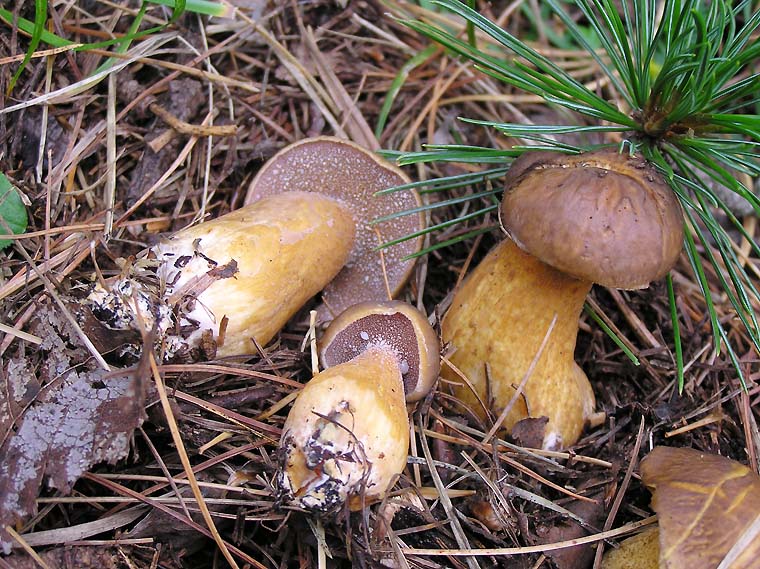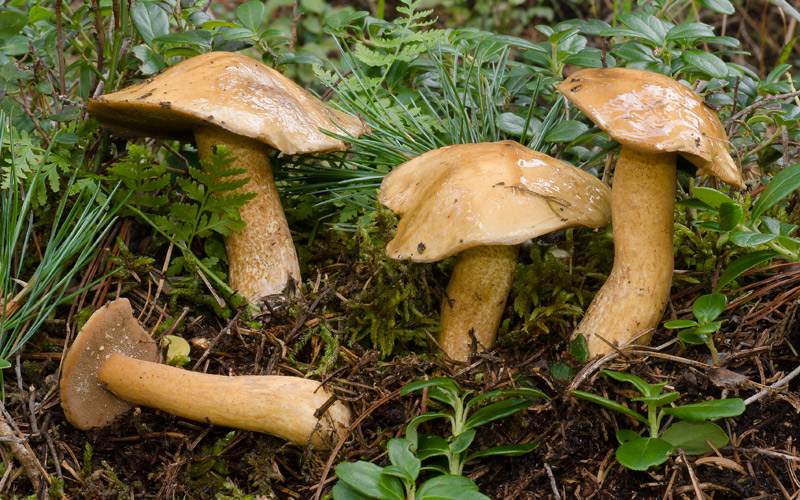Suillus plorans
Pine Boletus ( Suillus Plorans )
The stone pine boletus ( Suillus Plorans ), also known as Alpine granules or Arven Boletus, is a species of fungus in the family Schmierröhrlingsverwandten. It grows in symbiosis ( mycorrhiza ) with pineal pine trees, often along with the Ringed pine Boletus ( S. sibiricus subsp. Helveticus ).
- 6.1 Literature
- 6.2 Notes and references
Features
Macroscopic characteristics
The hat of the pine - Röhrlings has a diameter of 3-10 cm. He is ocher to orange- brown or dark fawn, sometimes yellow. Furthermore it is brown überfastert or punctured fibrous. In damp weather, the surface is slippery - slimy. Boy hats have a hemispherical shape, later they are curved to spread. The brim is about little or very little.
The lolly grown up a bit run-down tubes are usually much shorter than the Hutdicke. They are initially yellow-brown in older mushrooms olive - ocher-brown. The tube openings (pores) are relatively small ( less than 1 mm) and spherical shaped, but may be extended radially. They are often busy with milky Guttationströpfchen which later dry up and then take on a brownish color.
The spore powder is Olive Drab.
The stem is formed approximately cylindrically thickened clavate usually in the bottom half and less frequently thinner. He has a yellow color and is covered with glandular dots. These are young whitish, later cream to brown or violet-brown to almost blackish. Young specimens have also Guttationstropfen in the upper stem portion. A ring is missing. The Basalmycel has a fluffy pink color.
The flesh is saffron yellow; in the stem tip is tinted more lemon yellow, the lower end of the handle, it has a reddish brown color. It has a soft, slightly firmer consistency in the stem. The meat tastes mild, but slightly sour and smells like weak fruit and almond-like.
The meat reacts with potassium hydroxide bright purple. Sulfuric acid on the pore evoke an intense yellow color.
Microscopic characteristics
The 7.9 to 11.7 × 3.3 to 4.7 micron spores are elliptical shaped to fusiform, smooth and light brown. The basidia are 4- sporig and measure 25-35 × 5.5 × 8.0 microns. The clavate, sometimes spindle-shaped cystidia are 45-80 microns long and 6.5 to 14 microns wide. They usually have a leather -, olive - or reddish -brown color. They are encrusted with hyaline or brownish. They are primarily tufted in front of the pores; in the tubes, they are less frequent and more individually. The Hutdeckschicht consists of 3-7 ( -10 ) microns wide, septate and pigmented hyphae
Artabgrenzung
The pine - Röhrling must be distinguished from other lubricating boletes with glandular dots on the stem mainly by the yellow to orange- brown hat, orange to olivbräunlichen pores and occurrence in pineal pines. Very similar dark forms of Ivory Röhrlings (p. placidus ) can be - the fungus can with this 5 - needle-like pine species is also a connection to take. However, he has a brighter spore powder, a smooth hat and more reddish glandular points. The Ringlose butter mushroom ( P. collinitus ) has brighter pores and occurs exclusively under 2 - needle-like jaws.
Ecology and phenology
The pine - Röhrling is strictly linked to the pineal pine and occurs both in pure and in mixed stands. The species is widespread in montane to subalpine area. They colonized bare humus soils on calcareous, but also calcium-free surface. Often the fungus is associated with blueberry or cranberry.
The fruiting bodies are made from July to October.
Dissemination
The Zirbenröhrling occurs mainly in the central Alps. Outside this region it is very rare in Germany and in Slovakia ( High Tatras ) to be found. In the Alps, the fungus can be found up to an altitude of about 2,500 m above sea level. He was found in France, Italy, Austria and Switzerland. For Germany only few finds from the Bavarian Forest, the National Park Berchtesgaden and the Black Forest come.
Outside the natural range it was found in Hungary in artificially planted pineal pines.
Importance
The stone pine is edible Boletus.


_1.jpg)



_Kuntze_211065.jpg)


